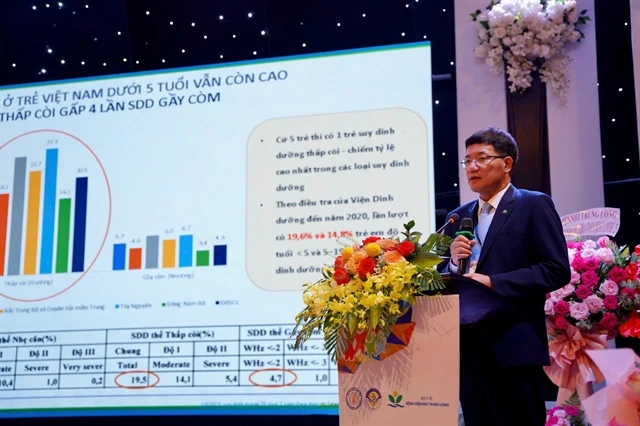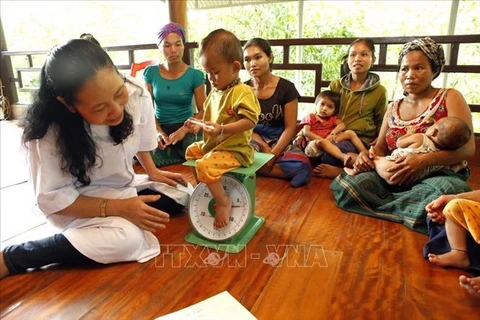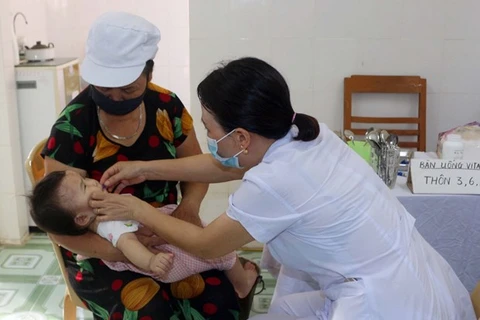
Thua Thien – Hue (VNA) - Vietnam sets a goal to reduce the stunting rate in under-5 children to below 15% by 2030, but this rate currently is still high at 18.2%.
If Vietnam does not actively deploy intervention measures both in hospitals and in the community, it will be difficult to achieve the set goal of reducing the stunting rate to below 15% by 2030.
Health experts were speaking at the 25th National Pediatric Congress, themed “From Science to Policy and Practice”, held in Hue city, the central province of Thua Thien – Hue, on November 1-2.
The event is an opportunity for local and international health experts and doctors to update their knowledge and exchange experiences in examination, screening and nutritional intervention for children. This is also an important opportunity for medical professionals to discuss advances in the field of paediatrics, especially child nutrition.
Speaking at the conference, Director of the health ministry's Department of Mothers and Children Dinh Anh Tuan said that underweight malnutrition in under-five children in Vietnam has decreased sharply, but the stunting rate is still high. On average, about two out of 10 children are stunted. The rate is especially high in ethnic minority and mountainous areas.
"Malnutrition, including stunting, affects physical strength, stature and intelligence of Vietnamese people," said Tuan.
According to the national nutrition survey in 2023, the stunting rate in children under 5 years old in Vietnam was 18%. Vietnam belongs to the group of countries with a rate of stunting in children under 20% - average level according to the classification of the World Health Organisation (WHO). However, this rate was still high in the northern midlands, mountains and Central Highlands, up to about 30%.
Dr. Phan Huu Phuc, General Secretary of the Vietnam Pediatric Association and Deputy Director of the National Pediatric Hospital said that the annual rate of reduction in stunting in children under five years old was slowing down, at less than one% per year since 2015.
Phuc also added that the height of Vietnamese adults is still in the 30% of countries with the lowest average height in the world. The average height of men is below 1.7m and women are below 1.6m.
According to Phuc, adult height depends on many factors, including stature in the first years of life. Malnourished and stunted children greatly affect their adult stature.
"Therefore, it is necessary to have timely nutritional interventions for children, in which the role of screening and early detection of the risk of stunting and malnutrition is very important," stressed Phuc.
Currently, each hospital has a different nutritional assessment screening table. There is no unified screening tool set. Evaluations mainly focus on acute malnutrition, often missing screening/intervention of children at risk of stunting; not focusing on the risk of malnutrition and intervention for children who are sick and at risk of malnutrition.
From this reality, experts from the Ministry of Health and the Vietnam Pediatric Association coordinated with hospitals to build a consensus on guidelines for screening nutritional interventions for pediatric patients.
Associate Professor Tran Minh Dien, Director of the National Pediatric Hospital, said: “Currently 100% of children coming for inpatient treatment at the hospital have been evaluated for nutritional screening and intervention was given to about 30% of children with signs of malnutrition.
“Specifically, after children are screened, doctors will give parents instructions and nutritional interventions with diet and oral nutritional foods suitable for each child, not only for severely malnourished children but also for children at risk,” said Dien.
According to experts, one of the new points in addressing malnutrition in children today is to focus on screening groups of children treated in both outpatient and inpatient hospitals. In addition, doctors will focus on evaluating chronically malnourished children and early detection and intervention of the risks of acute and chronic malnutrition and stunting in children.
At the conference, the Vietnam Pediatric Association made six recommendations, calling on hospitals to implement them systematically, for paediatricians to practise and join hands to drive back malnutrition and improve the stature of Vietnamese people.
In particular, outpatients will be screened for nutritional risk factors. Inpatients will be screened, evaluated for nutritional status, diagnosed and prescribed nutritional treatment within 36 hours from the time of admission and recorded in the medical record. Screening, assessment and nutritional interventions should be maintained throughout treatment and before the patient is discharged from the hospital. Inpatient and outpatient nutritional intervention plans for malnourished children must be appropriate and ensure sufficient time.
Phuc added that the benefits of oral nutritional supplements of medical nutritional foods help reduce hospital stays by 14.8% and medical costs by 9.7%./.






















